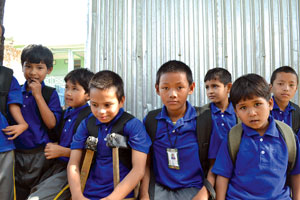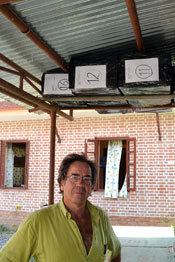 |
Into this fray have stepped in many charities to help the most vulnerable sections of society. And one of them is in Sankhu on the Valley's eastern edge, far from the chaos of the city, a shelter for war orphans, abandoned, sick and injured children. Hamro Gaun Eco Village educates the children, nurses them back to health, provides psycho-social counseling and re-integrates them back into society.
"The children come from extremely difficult and unfortunate backgrounds. Many of them are orphans whose parents were killed during the insurgency by the state and the rebels, but no one is going around saying 'your side killed my father'," says Ren� Veldt, a Dutch national.
Veldt started the shelter in 2006 with support from the Dutch aid group, Stichting Veldwerk, to help Nepali children in a small way. He admits the scale of the problem is much larger, and his work is just a drop in the ocean.
Birkha is from Kalikot and was found in Bir Hospital taking care of his elder brother who was injured in a landmine, just days after the government declared Nepal 'mine free'. Birkha is now attending school, and taking care of his brother.
 PICS: SUNIR PANDEY SCHOOL TIME: Khum (on crutches) with Pemba (on his left) and classmates at Evergreen English School. |
Pemba Tsering Tamang was 11 when he was found living in a hovel infested with rats in Jorpati. Pemba was being taken care of by his 15-year-old brother who worked as a carpet weaver. Underfed and neglected, he was critically ill with bone tuberculosis. BKN took him to the Hospital and Rehabilitation Centre for Disabled Children (HRDC) in Banepa where he spent months recuperating. Pemba can now walk on his own, although he still needs to wear a brace under his shirt.
"He wants to be an artist when he grows up," confides one of Pemba's friends. Shy but unable to hide his smile, Pemba whispers to his caretaker that he actually wants to be a doctor.
Khum Bahadur Pandey from Baglung is another disabled member of Hamro Gaun family who dreams of becoming a doctor. Suffering from what appeared to be polio, he was admitted to HRDC by Bal Kshetra staff. Today, he walks on crutches and is fond of dancing with his friends. His progress in school has been so encouraging that HRDC started a fund in his name to help with his college education.
However, not all the children are lucky. Orphans and children who cannot locate or identify their parents find themselves in a precarious position. Without at least one parent and a permanent address, they can't apply for citizenship and are in danger of living without mothers and a motherland.
Pemba, who wants to be a doctor and maybe also an artist, can't get admitted into a university without citizenship. His brother is married, but not in contact anymore and nobody knows who his parents are.
Safety first
 |
"Most Kathmandu houses will fall like dominoes when an earthquake hits. All state institutions � the police, the army, the bureaucracy are housed in unsafe buildings, the ones who are supposed to provide relief will themselves be paralysed," says Veldt about the Valley's lack of preparedness. Hamro Gaun stores tents, food, medical and sanitary supplies to last at least a week. "Other Sankhu residents will probably come to us for help," says Veldt.
Along with safety, Hamro Gaun is a model for energy efficiency and is a self-sustaining home. The shelter has a solar panel that keeps all buildings brightly lit at night while the surrounding villages are in darkness during power cuts. Fruits and vegetables for the children and staff are gathered from the organic garden found in the premises, and all this is cooked in biogas generated from the shelter's waste.
Read also:
Latrines save lives, ROBIN GIRI in DANG
Community helps its poorer households to ensure sanitation and save children's lives in rural Nepal


